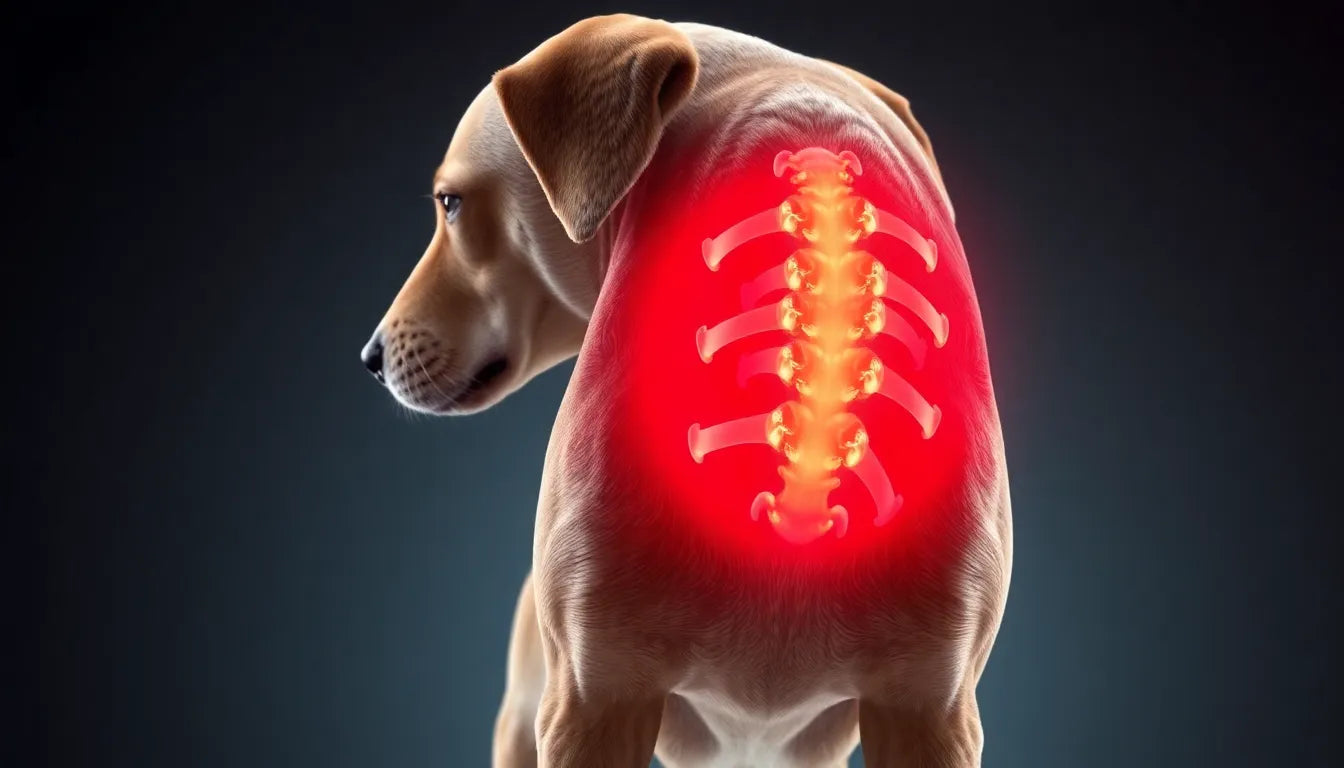A herniated disc in dogs is a condition that affects the spine, where the intervertebral discs—a series of small, cushion-like structures—become damaged or displaced. These discs play a crucial role in maintaining flexibility and absorbing shock in a dog's spine. When a disc herniates, it can put pressure on the spinal cord, leading to a range of health issues. One of the most common causes of herniated discs in dogs is Intervertebral Disc Disease (IVDD), a degenerative condition that affects the disc's ability to function properly over time. Understanding this condition is vital for ensuring timely and effective treatment, which can significantly improve a dog's quality of life.
Prevalence and impact on canine health
Herniated discs are a relatively common issue in dogs, particularly in certain breeds that are genetically predisposed to spinal problems. Breeds such as Dachshunds, Bulldogs, and Corgis are more susceptible due to their unique body structures and genetic factors. The impact of a herniated disc on a dog's life can be profound, affecting their mobility and overall well-being. Symptoms can range from mild discomfort and limping to severe pain and paralysis, depending on the severity of the herniation. This condition not only affects a dog's physical health but can also lead to emotional distress for both the pet and its owner.
Empowering pet owners with knowledge
The purpose of this blog post is to provide a comprehensive guide on the symptoms, treatments, and recovery processes associated with herniated discs in dogs. By equipping pet owners with detailed information, we aim to empower them to make informed decisions about their pet's health care. Understanding the signs of a herniated disc and the available treatment options can help pet owners take proactive steps to manage the condition effectively. Whether through conservative management or surgical intervention, early detection and treatment are key to improving outcomes for dogs affected by this condition.
In the following sections, we will delve deeper into the specific symptoms to watch for, the diagnostic methods veterinarians use, and the various treatment options available. We will also discuss the prognosis and recovery timelines for dogs with herniated discs, providing practical advice on how to care for your pet during their recovery journey. By gaining a deeper understanding of herniated discs in dogs, pet owners can better support their furry companions and help them lead healthier, happier lives.
Identifying symptoms and diagnosing herniated discs in dogs
Recognizing the symptoms of a herniated disc in dogs is crucial for early intervention and treatment. Common signs include limping, lameness, or an unsteady gait, which may indicate discomfort or pain in the spine. Dogs might also drag their back legs or stumble, reflecting a loss of coordination. A hunched posture is another telltale sign, often resulting from pain or discomfort in the back or neck area. In more severe cases, dogs can experience weakness or even paralysis, alongside a loss of bladder or bowel control. These symptoms necessitate immediate veterinary attention to prevent further damage and to initiate appropriate treatment.
Diagnosis of a herniated disc typically begins with a thorough physical examination by a veterinarian. This evaluation helps to assess the dog's neurological function and identify any areas of pain or discomfort. To confirm the diagnosis and evaluate the extent of the disc herniation, imaging techniques such as X-rays, MRI, or CT scans are often employed. These diagnostic tools provide detailed images of the spine, allowing veterinarians to pinpoint the location and severity of the herniation. Early and accurate diagnosis is essential for determining the best course of treatment and improving the dog's prognosis.
Exploring treatment options for herniated discs in dogs
Treatment for herniated discs in dogs can vary significantly based on the severity of the condition. Conservative treatment is often the first line of defense, especially in mild cases. This approach includes strict rest and restriction of movement to prevent further injury. Pain relief medications and anti-inflammatory drugs are typically prescribed to manage discomfort and reduce inflammation. Additionally, physiotherapy and supportive therapies, such as acupuncture or laser therapy, can aid in recovery by improving mobility and reducing pain.
In more severe cases, where conservative treatment is insufficient, surgical intervention may be necessary. Surgery is generally indicated when there is significant spinal cord compression or when a dog does not respond to conservative measures. Various surgical procedures are available to relieve pressure on the spinal cord, such as decompressive surgery or fenestration. While surgery carries inherent risks, it often offers a higher success rate in restoring mobility and alleviating pain, particularly when performed early in the course of the disease.
Prognosis and recovery: what to expect
The prognosis for dogs with herniated discs depends on several factors, including the severity of the condition, the timeliness of treatment, and the dog's overall health. Recovery times can vary widely, ranging from several weeks to months, and are largely influenced by the extent of spinal cord damage and the treatment approach taken. Dogs with mild symptoms tend to have a more favorable prognosis and can often return to normal activities with appropriate care and management.
Early intervention plays a pivotal role in improving outcomes, as prompt treatment can prevent further neurological damage and facilitate recovery. Pet owners should work closely with their veterinarian to monitor their dog's progress and adjust treatment plans as needed. With proper care and management, many dogs can recover from a herniated disc and regain a good quality of life. Understanding the recovery process and being prepared for the time and effort involved is essential for supporting your pet's journey back to health.
Additional care and prevention for herniated discs in dogs
Proper post-treatment care is crucial for dogs recovering from a herniated disc. Maintaining a healthy weight is essential to minimize stress on the spine, as excess weight can exacerbate the condition. Pet owners should work with their veterinarian to develop a balanced diet plan tailored to their dog's specific needs. Additionally, avoiding strenuous activities, such as jumping or climbing stairs, is important to prevent further injury. These activities can place undue pressure on the spine, potentially leading to additional herniations.
Supportive therapies, including hydrotherapy, can be particularly beneficial during the rehabilitation process. Hydrotherapy allows dogs to exercise in a low-impact environment, promoting muscle strength and flexibility without placing stress on the spine. Regular physiotherapy sessions can also aid in recovery by enhancing mobility and reducing pain.
Prevention strategies are key to minimizing the risk of future disc herniations. Pet owners should be vigilant in monitoring their dog's activity levels and ensuring they do not engage in high-risk behaviors. Providing a safe environment with ramps or steps to help dogs navigate furniture or vehicles can reduce the likelihood of injury. Regular veterinary check-ups are also important for early detection and management of potential spinal issues.
Success stories and real-life examples
Hearing about successful recoveries can be encouraging for pet owners facing a herniated disc diagnosis. Many dogs have regained full mobility and quality of life following appropriate treatment and care. For instance, a Dachshund named Max underwent surgery for a severe herniated disc and, with diligent post-operative care, was able to resume his favorite activities within a few months. Such stories highlight the importance of early intervention and comprehensive care in achieving positive outcomes.
Frequently Asked Questions
What is the most common cause of herniated discs in dogs?
The most common cause of herniated discs in dogs is Intervertebral Disc Disease (IVDD), a degenerative condition that affects the spine. IVDD is prevalent in certain breeds, such as Dachshunds and Bulldogs, due to genetic predispositions.
How can I tell if my dog has a herniated disc?
Key symptoms of a herniated disc in dogs include limping, unsteady walking, dragging back legs, a hunched posture, and signs of pain or weakness. In severe cases, paralysis or loss of bladder and bowel control may occur. If you notice any of these symptoms, consult a veterinarian promptly.
Is surgery always necessary for herniated discs in dogs?
Surgery is not always necessary for herniated discs in dogs. Many cases can be managed conservatively with rest, medication, and supportive therapies. However, surgery may be required in severe cases where there is significant spinal cord compression or if conservative treatments fail to provide relief.
What is the recovery process like for dogs after surgery?
Post-surgery recovery for dogs involves a period of strict rest and gradual reintroduction of activities. Pain management and physiotherapy are crucial components of the recovery process. Most dogs begin to show improvement within a few weeks, but full recovery can take several months, depending on the severity of the condition.
Can herniated discs in dogs be prevented?
While it may not be possible to completely prevent herniated discs, certain measures can reduce the risk. Maintaining a healthy weight, avoiding high-impact activities, and providing a supportive environment can help protect your dog's spine. Regular veterinary check-ups are also important for early detection and management of spinal issues.


















